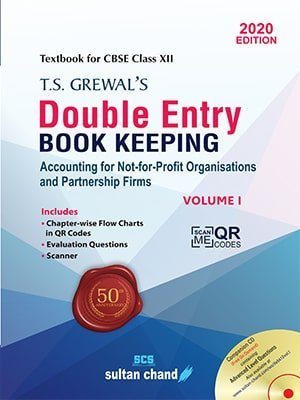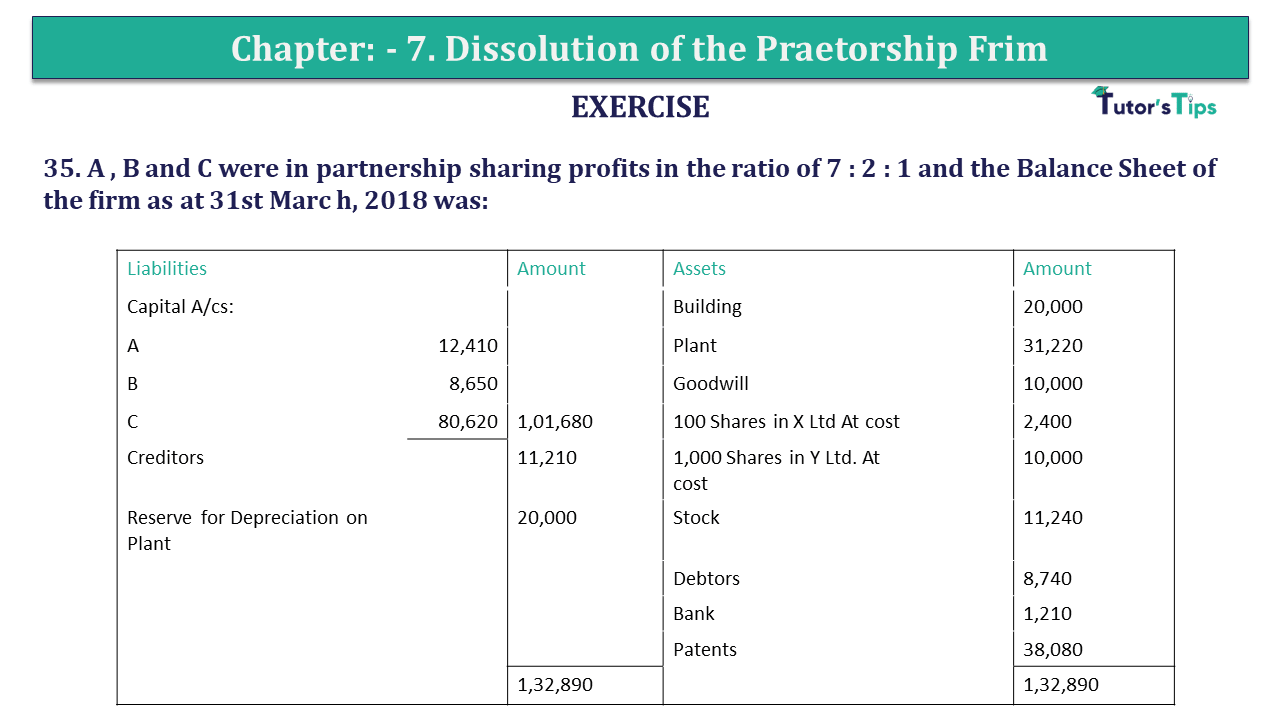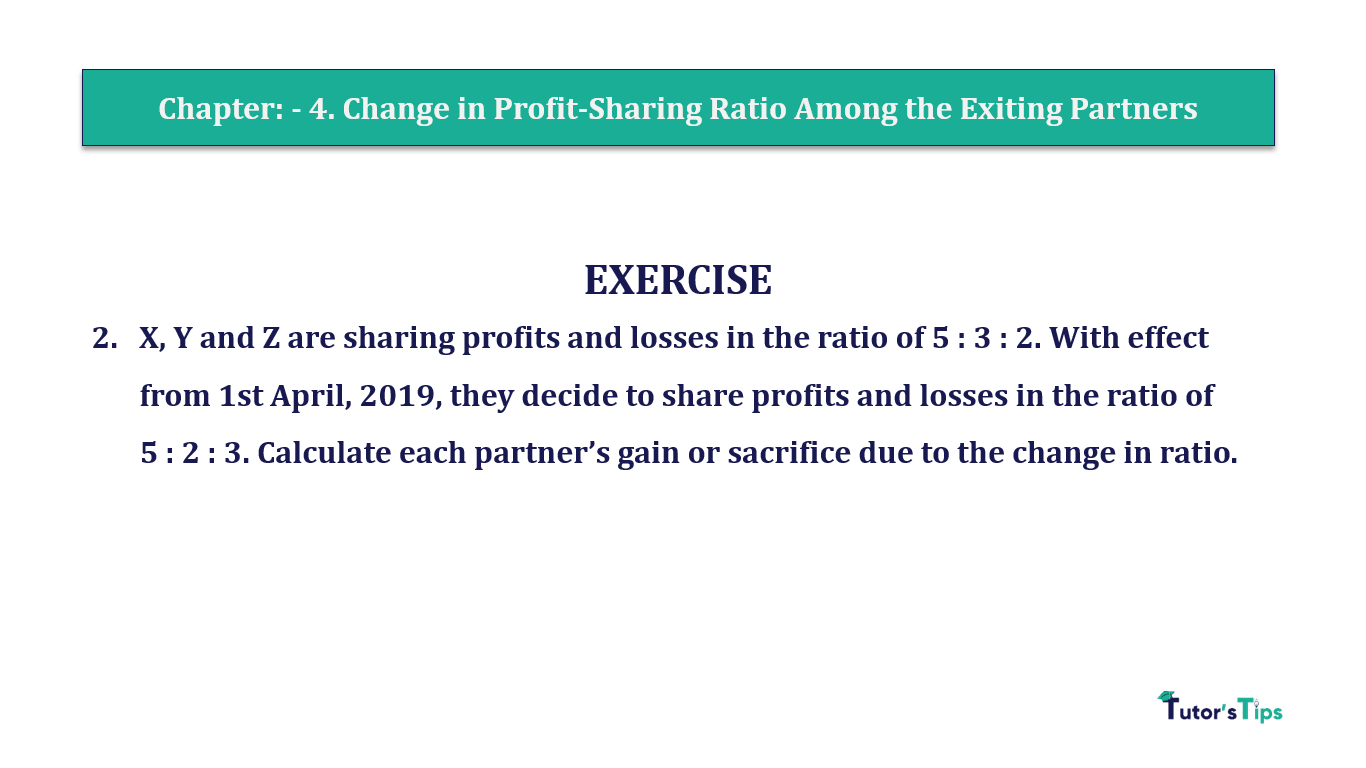Question 35 Chapter 7 of +2-A
35. A, B and C were in partnership sharing profits in the ratio of 7: 2: 1 and the Balance Sheet of the firm as at 31st March 2018 was:
| Liabilities | Amount | Assets | Amount | |
| Capital A/cs: | Building | 20,000 | ||
| A | 12,410 | Plant | 31,220 | |
| B | 8,650 | Goodwill | 10,000 | |
| C | 80,620 | 1,01,680 | 100 Shares in X Ltd At cost | 2,400 |
| Creditors | 11,210 | 1,000 Shares in Y Ltd. At cost | 10,000 | |
| Reserve for Depreciation on Plant | 20,000 | Stock | 11,240 | |
| Debtors | 8,740 | |||
| Bank | 1,210 | |||
| Patents | 38,080 | |||
| 1,32,890 | 1,32,890 |
It was agreed to dissolve the partnership as on 31st March 2018 and the terms of dissolution were—
a A to take over the Building at an agreed amount of 31,500;
b B who was to carry on the business, to take over the Goodwill, Stock and Debtors at book value, the Patents at 30,000 and Plant at 30,000 and Plant at 5,000. He was also to pay the Creditors;
c C to take over shares in X Ltd. at 15 each and d The shares in Y Ltd.to be divided in the profit-sharing ratio.
Show Ledger Accounts recording the dissolution in the books of the firm.
The solution of Question 35 Chapter 7 of +2-A: –
| Realization Account |
|||||
| Particular |
Amount | Particular | Amount | ||
| Building | 20,000 | Creditors | 50,000 | ||
| Plant | 31,220 | Reserve for Depreciation on Plant | 50,000 | ||
| Goodwill | 10,000 | ||||
| 100 Shares in X Ltd | 2,400 | A’s Capital A/c: | |||
| 1,000 Shares in YLtd | 10,000 | Building | 31,500 | ||
| Stock | 11,240 | Shares of Y Ltd. | 7,00 | 38,500 | |
| Debtors | 8,740 | ||||
| Patents | 38,080 | B’s Capital A/c: | |||
| B’s Capital A/c Creditors | 11,210 | Goodwill | 10,000 | ||
| Stock | 11,240 | ||||
| Debtors | 8,740 | ||||
| Patents | 30,000 | ||||
| Plant | 5,000 | ||||
| Shares of Y Ltd. | 2,000 | 66,980 | |||
| C’s Capital: | |||||
| Shares of X Ltd. | 1,500 | ||||
| Shares of Y Ltd | 1,000 | 2,500 | |||
| Loss transferred to: | |||||
| A’s Capital A/c | 2,590 | ||||
| B’s Capital A/c | 740 | ||||
| C’s Capital A/c | 370 | 3,700 | |||
| 1,42,890 | 1,42,890 | ||||
| Partners’ Capital Account |
|||||||
| Part. | A | B | C |
Part. |
A | B | C |
| To Realization A/c | 38,500 | 66,980 | 2,500 | By Balance B/d | 12,410 | 8,650 | 80,620 |
| To Realization A/c Loss | 2,590 | 740 | 370 | By Realization A/c | – | 11,210 | |
| To Cash A/c | – | – | 77,750 | By cash A/c | 28,680 | 47,860 | – |
| 41,090 | 67,720 | 80,620 | 41,090 | 67,720 | 80,620 | ||
| Bank Account |
|||||
| Particular |
Amount | Particular | Amount | ||
| Balance b/d | 1,210 | C’s Capital A/c | 77,750 | ||
| A’s Capital A/c | 28,680 | ||||
| B’s Capital A/c | 47,860 | ||||
| 77,750 | 77,750 | ||||
Advertisement-X
T.S. Grewal’s Double Entry Book Keeping +2 (Vol. I: Accounting for Not-for-Profit Organizations and Partnership Firms)
- Chapter No. 1 – Financial Statement of Not-For-Profit Organisations
- Chapter No. 2 – Accounting for Partnership Firms – Fundamentals
- Chapter No. 3 – Goodwill: Nature and Valuation
- Chapter No. 4 – Change in Profit-Sharing Ratio Among the Existing Partners
- Chapter No. 5 – Admission of a Partner
- Chapter No. 6 – Retirement/Death of a Partner
- Chapter No. 7 – Dissolution of a Partnership Firm
T.S. Grewal’s Double Entry Book Keeping (Vol. II: Accounting for Companies)
- Chapter No. 8 – Company Accounts – Accounting for Share Capital
- Chapter No. 9 – Company Accounts – Issue of Debentures
- Chapter No. 10 – Redemption of Debentures
T.S. Grewal’s Double Entry Book Keeping (Vol. II: Accounting for Companies)
- Chapter No. 1 – Financial Statements of a Company
- Chapter No. 2 – Financial Statement Analysis
- Chapter No. 3 – Tools of Financial Statement Analysis – Comparative Statements and Common- Size Statements
- Chapter No. 4 – Accounting Ratios
- Chapter No. 5 – Cash Flow Statement
Check out T.S. Grewal +2 Book 2020@ Official Website of Sultan Chand Publication








Leave a Reply